
|   |

|   |
The west takes on eastern hues - Dr S D Desai e-mail: sureshmrudula@yahoo.co.in November 29, 2013 I went to the 3rd Purva International Dance Festival (23 - 24 November ‘13), organized by Sharad Pandya in Vadodara, with the curiosity to see how foreigners perform Indian classical dances. I returned with surprise and pleasure. The Gannas, Ashas, Eleanoras and Angelinas who performed demonstrated that with the seriousness and humility the process entails they pursued their study of not only Indian classical dance but also the Indian way of life it is an integral part of. They set an example to those in India who ape, rather than study, western ways. Ganna Smirnova (Kiev, Ukraine) is a knowledgeable scholar and author of ‘Indian Temple Dances – Tradition, Philosophy and Legends.’ “Western dance is stretched to its limits physically,” she observes in a conversation, “Indian classical dance explores the unlimited space within.” Endowed with the right figure and elegantly accomplished, she emerges comparable to good Bharatanatyam dancers of India in Devimangalam, Geetagovinda excerpts and Tillana. Asha Ponikiewska (Poland), who holds a Diploma in Hindi and is a B.A. with English, also specializes in Comparative Literature, knows Sanskrit, Yoga and Chhau. Tall and confident, she is comfortably in sync with the rhythm and keenly explores space to express bhavas from within in Bharatanatyam. She pleasingly performed Krishna nee begane baaro... (Come, Krishna, without any delay…) taking time for expression in slow pace. 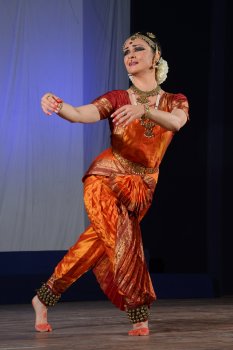 Ganna Smirnova  Asha Ponikiewska 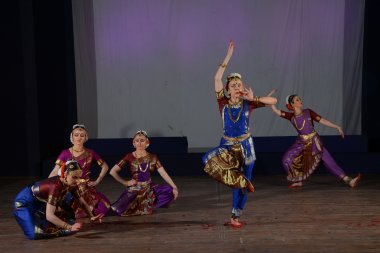 Nataraj School 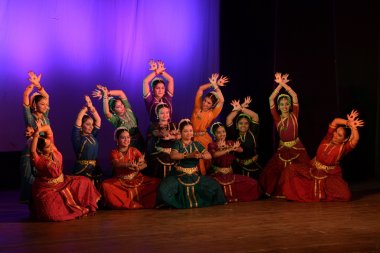 Purva group The six-member bevy of pretty Russian girls, led by the ever-smiling Eleonora Ukhanova, Art Director, Nataraja School for Bharatanatyam and Odissi, is a delight to watch in performance. Eleonora and her charming daughter Angelina, chief choreographer, relate their initial fascination for Indian culture to films Awara and Sholay. Eleonara also talks about novels like Tagore’s ‘Gora’ she has read in translation! In pleasingly choreographed items ranging from Moksh, Vaaman and Tillana, they agreeably surprised viewers as much with comfortable angabhangi as footwork though they left scope for a greater flow in movement and more intricate expression. Our dance treatises have developed a visual vocabulary with nuanced differences in connotations. The elements minutely identified with reference particularly to the movement of the eyes, hands and feet emulating nature are not isolated and static. Coordinated, they create structures integral to a creation. Prakruti Varnan, presented as the inaugural item by the hosts, Purva group, remained joyously engaging beginning with the creation of the universe followed by creatures like fish, snake and peacock, beautiful in their movement. The concluding piece at the festival was a Garbo, a folk dance of Gujarat, zestfully done by senior members of Purva. In the presence of its director B.K. Shyamprakash, Keshava Nrithya Shala (Bangalore) got introduced with sparkling traditional performances by Shruthi, Shyama and Raghunandan. The Varnam singing praise to Goddess Parvati was especially noteworthy. She is portrayed here in earnest as the destroyer of ashubha and protector of all that is shubha. Of late, there have been attempts to associate with real life situations qualities of a true Vaishnav described by Narasimh Mehta in his famous devotional song, dear to Mahatma Gandhi. Raghunandan in his Padam visualized with felicity the words denoting those qualities. 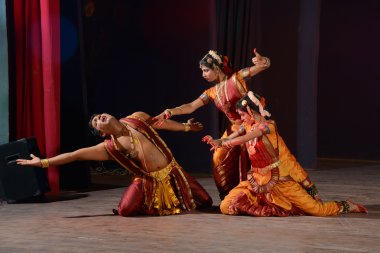 Keshava Nrithya Shala  Manasi & Raghunandan  Manasi & Sharad Pandya 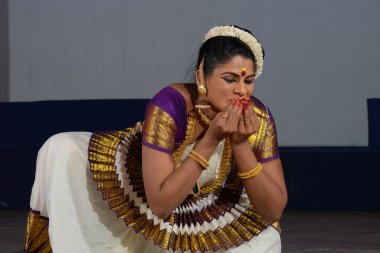 Swapna Rajendrakumar When episodes from our epics are presented, ‘tatah kim?’ is known to everyone. The focus of attention is on what sensitivity they are portrayed with. In Seeta Apaharana in Awadhi set to Carnatic music, choreographed with a sense of drama and with skills in both Bharatanatyam and Odissi by B. K. Shyamprasad (Keshava) and Sharad Pandya (Purva), Manasi as Shoorpanakha and Seeta is brilliantly expressive and Raghunandan portrays a virile Lakshman and a dheerodatta Ram. Sharad Pandya intelligently limits his movement as Ravana and with eyes and body language suggests his power, personality and craftiness. One with her dance, Swapna Rajendrakumar remained in rapport with the spectators in all her three items in Mohiniattam style. The music with its delectable Keralite flavour in each was distinctly different and Swapna in her flowing languid movement, intricate mudras and varied expression touched the moods it evoked. The earthily lyrical joyous nritta of Mukhachalam flows into the vatsalya bhava of Irayiman Thampi’s popular lullaby Omana Tingal and the culmination is reached in the celebration of Jeeva dissolving in the all-pervading mangala tattva. Dr. SD Desai, a professor of English, has been a Performing Arts critic for many years. Among the dance journals he has contributed to are Narthaki, Sruti, Nartanam and Attendance. His books have been published by Gujarat Sahitya Academy, Oxford University Press and Rupa. After 30 years with a national English daily, he is now a freelance art writer. He guest-edited attendance 2013 with the theme Classical Dance and Modern Times. |